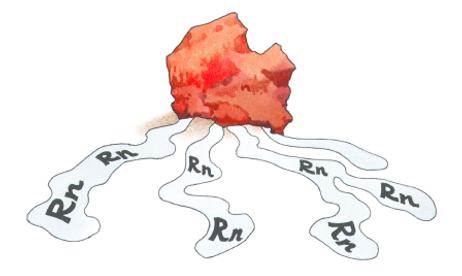Radon is a colorless, odorless radioactive gas naturally found in the environment. It is found in all 50 states, but some states have more of a radon problem than others. Homeowners in the particularly problematic states are encouraged to test their homes for radon and make necessary adjustments if higher than normal levels of the gas are found. However, during the school year, students and staff spend at least as much time at school as they do at home. Are the schools testing for radon? Let's take a look and see.
The Dangers of Radon
Radon originates in granite deposits located deeply underground. The gas can get into buildings by seeping in through cracks in the foundation, openings around drains, or under basement slabs. According to the Environmental Protection Agency, radon is one of the most serious health problems facing our population today. While this gas does not pose immediate health risks the way carbon monoxide does, over time, radon exposure can significantly increase one's risk for lung cancer. In fact, radon exposure is the second leading cause of lung cancer in this country, right behind cigarette smoke.
Radon gas decays overtimes, evolving into radioactive particles that can get into lung tissue and cause damage. Over time, this damage can lead to some types of lung cancer. The EPA cites three factors that determine your risk of lung cancer from radon exposure:
- The level of radon you are exposed to
- The duration of your exposure
- Your smoking habits in addition to your radon exposure
Because radon does not have an odor or taste, there is no way to detect its presence in a building without testing for the gas. The testing process is relatively easy and inexpensive, and the EPA recommends that all schools across the country conduct radon testing to keep the environments safe for the children and staff that spend their days in the buildings. The protocol for testing includes the following steps:
- Initial, short-term testing to determine current radon levels within each classroom in the school
- Follow-up short and long-term testing in classrooms where levels were unusually high to monitor improvements and annual averages of radon levels in those areas
- Action to reduce radon levels in areas where readings were higher than 4 pCi/L
The good news is that in addition to easy, cost-effective testing, the fixes for high radon levels are also usually relatively straightforward, inexpensive, and effective. Unfortunately, not all schools are taking the radon risk as seriously as they should, and many have not conducted the recommended testing or followed up on negative test results.
This video explains what students, parents, and teachers need to know about radon.
High Radon Levels in Tennessee
Recent radon tests in Tennessee schools revealed that 29 schools in the Nashville area had radon levels higher than what was recommended by the EPA. According to a report at RadonLeader.org, Two Rivers Middle School had some of the highest radon levels, with unsafe amounts showing up in fifth-grade classrooms within the school. Metro Nashville Public School officials sent an email out to staff following the testing, assuring them the elevated levels of radon were no cause for alarm.
"It is important to know there is no immediate danger and that the EPA does not recommend avoiding or evacuating an area or building during mitigation efforts – this holds true even in cases where extremely high levels of radon have been detected," the email read. The school also posted the radon testing results for 35 schools on the district website, and letters were sent home with students regarding the status of their individual schools.
Schools that had high radon readings will be retested to determine if levels are still high. Cathy Glapa, radon program coordinator for the Tennessee Department of Environment and Conservation said retesting is important to determine if high radon levels are a real concern. Glapa told RadonLeader.org, "There are many factors that affect radon readings. Ventilation and how it circulates through the school, and the weather, higher in winter months, can be a factor."
If readings remain high, schools may need to take steps to reduce their radon levels, in accordance with recommendations from the EPA.
Radon Testing in Colorado Inconsistent
Colorado is another state that has a greater risk of radon exposure since the gas is abundant in Colorado soil. Despite this concern, local news stations have found many school districts paying little attention to the potential radon risks in their school buildings. According to a report last year from 7 News, hundreds of schools around the state have failed to either test for radon exposure or fix problems after discovering higher than average radon levels in some classrooms.
The 2010 investigation found that 293 schools in 77 districts ignored state regulations issued in 1991 that required all schools to undergo radon testing. In Denver Public Schools, where testing was done and high levels of radon were found, few schools did anything to rectify the problem or retest the classrooms at a later date.
A report at Education News Colorado one year later showed that many Colorado schools still admit they never did the required radon testing. Some that did do not have any sort of documentation proving the tests were done or providing accurate results regarding radon levels. Health officials in the state advise parents to contact their local school board if they have concerns about radon levels in their children's school. Officials would also like to see teachers insist on testing in their classrooms.
This video offers another look at what parents, teachers, and students need to know about radon.
Radon is a real issue, and if it is prevalent in your area, take action to have your child's school test for the gas.
Questions? Contact us on Facebook. @publicschoolreview












